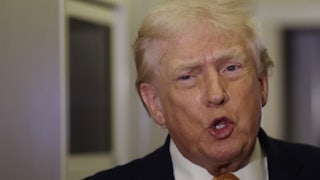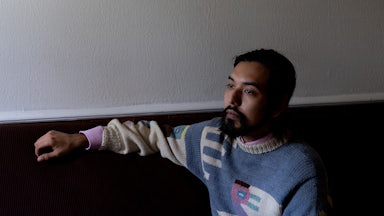On this August day, extreme heat and Republicans have invaded Milwaukee. It’s 96 degrees at noon, and feels 10 degrees warmer as the sun bakes the asphalt on Dr. Martin Luther King Jr. Drive. Downtown, TV people are sweating through their suits doing live shots outside the Milwaukee Bucks’ basketball arena, which will host the GOP’s kickoff presidential debate later tonight. It’s a rehearsal of sorts for next summer, when the GOP will return to the city for the Republican National Convention. The convention likely will be different from today, in that Donald Trump, assuming he remains out of prison, may actually attend.
About a mile uptown, 65 activists, nearly all of them Black and most of them young, pile off a coach bus on MLK Drive. Within minutes, they occupy about four adjoining offices on the second floor of a beautifully restored old brick building in Milwaukee’s historic Bronzeville neighborhood. They’re running on adrenaline and caffeine after a full day in transit, most of them from Florida and Missouri. They’re sitting on the carpeted floor, preparing snack packs heavy on Doritos and Sun Chips, water bottles and bags of ice. Smartphones are ringing. Scripts are being passed around. They’re changing into the red “Fight for $15” shirts they’ll wear to protest the Republican debate.
“I want them to hear our voice and let them know that workers need to be heard, and that we deserve a fair living wage and the right to be treated equally,” says Jamelia Fairley, 28. She works at McDonald’s in Sanford, Florida.
Right now, they’re definitely being heard downstairs at Black and White Barbershop. Every time a bag of ice thuds against the floor, causing a ruckus below, the barbers respond by yelling fruitlessly at their upstairs neighbors. It’s just one of the political juxtapositions of the day. Another one: Beside an elevated interstate highway that bisects downtown, a large billboard paid for by the Biden campaign shows Dark Brandon peering down at drivers with his red laser eyes, touting his measure cutting prescription costs. A bus, wrapped in a U.S. flag and a “Joe Gotta Go” slogan, happens to drive by the billboard. It’s in town for the debate as part of a national effort to mobilize Black voters to switch to the GOP.
The “Joe Gotta Go” bus may want to visit the barbers. Inside Black and White, the AC is on, and the sun streams in through large windows that front the shop. The Little League World Series plays on the TV. The dozen young men, all of them Black, make lunch plans. Here, we’re sitting in what today is ground zero of the national political conversation. The barbers’ conversation may delight GOP strategists.
Nathan Gaines is 43 years old and a barber here. He’s wearing a gray camo-patterned Black Lives Matter tank top and black And1 shorts. Gaines has lived in Milwaukee most of his life, save for a three-year tour in the Army, when the ex–combat engineer was stationed in Missouri and Georgia. When he was in his twenties, the presence of Barack Obama on the presidential ballot sparked a political awakening.
“I just feel like it’s a privilege to be able to vote,” he says. “You know, we didn’t always have that opportunity. There are a lot of folks that fought, bled, and died for that privilege.”
Gaines has always voted Democratic, but doesn’t really identify with either major party and has lost enthusiasm with each passing cycle. “They’ll do all the campaigning and all the fancy talk,” he says of politicians. “Once they get elected, they throw [Black voters] to the wayside.”
At this point in the conversation, his tone shifts. And maybe it’s not too surprising. The GOP now operates a field office just down the street from the barbershop, in the heart of deeply Democratic Bronzeville. They do outreach via ads on Black radio. They’re making an effort. It’s possible some of the themes have percolated up through the community. Would he consider switching sides—from Joe Biden to Trump—this time?
“If [they’re] the two candidates, I’m going Republican,” he says. “Ain’t that crazy, ain’t that wild? But yeah, I am.”
He says he knows Donald Trump isn’t perfect and probably is racist.
“But all of them are,” he says of politicians. “Biden is, too. He had something to do with the crime bill, and it was a lot of folks being locked up.”
He likes Trump’s muscular posture on dealing with migrants who entered the country illegally, and his pro-business stances.
“I call him Big T,” he says. “You know, that’s Big T, and we gotta get some order around here.... I don’t know if he can come and fix everything. But I think he can put us back on the right track.”
Jay Whisenten, 33, later chimes in. He’s part owner and a barber at Black and White.
“I felt that a lot of things that he says is garbage,” he says of Trump. “I’m not necessarily going to agree with everything that he does.”
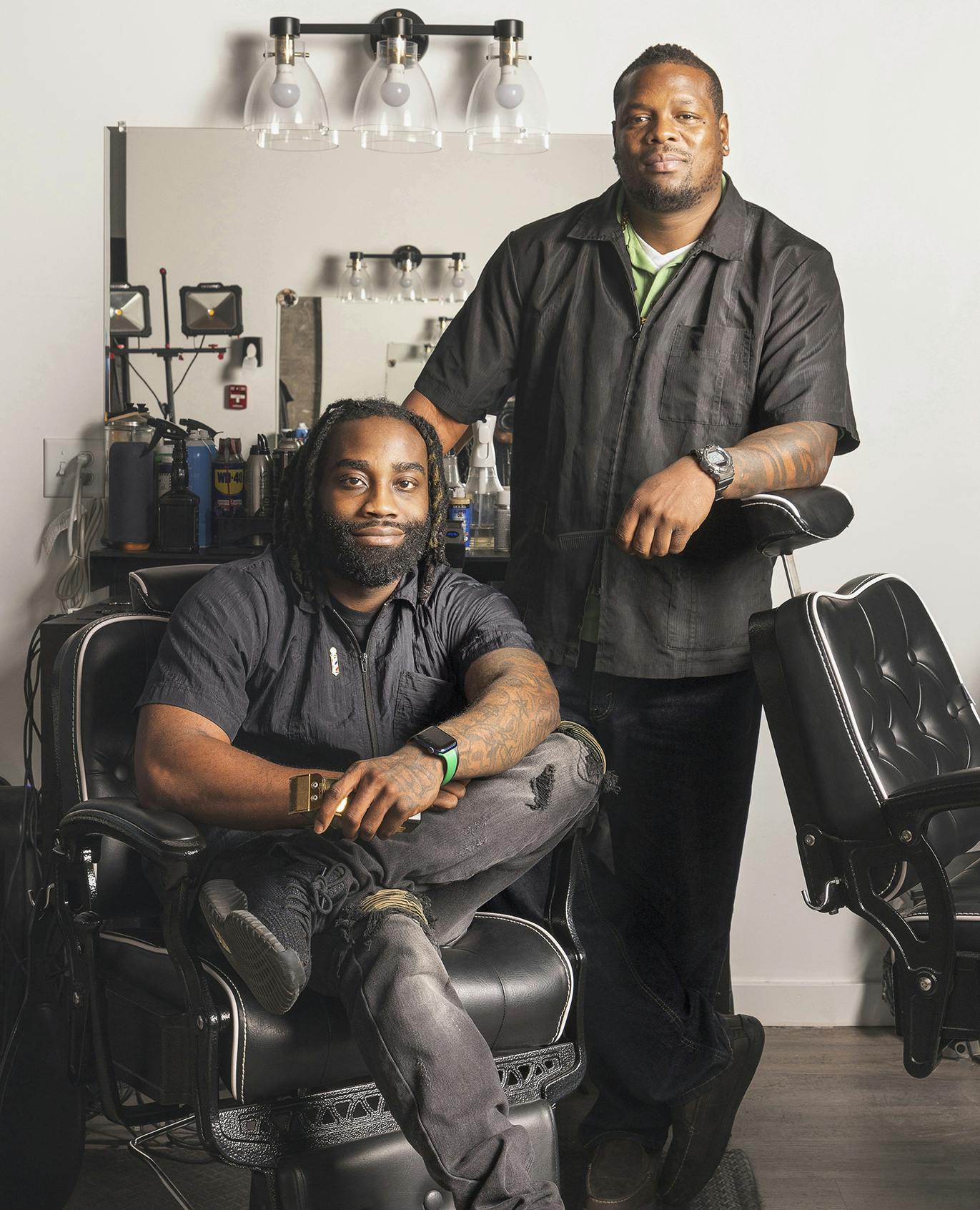
But for Whisenten, the difference between the two leading candidates comes in the checks: From his perspective, Trump delivered stimulus checks during the Covid-19 shutdowns that kept people’s heads above water. The barbershop got Paycheck Protection Program funds to keep paying employees, according to federal data. Biden, conversely, tried but was ultimately blocked by the Trump-heavy Supreme Court from enacting student loan debt relief. Whisenten still owes about $10,000 in loans from trade school. He understands that Biden tried but had the measure blocked. He will vote in 2024 but remains undecided on which candidate.
Are Gaines and Whisenten just two barbers with an independent streak, or canaries in the coal mine for Democratic fortunes in 2024? They matter due to the lopsided support among Black Americans for Democrats, historically and recently: Biden won 92 percent of the Black vote nationally, including 87 percent of Black male voters, in 2020. Any erosion in that support can play an outsize role, because we’re in Wisconsin, home to the nation’s most coveted 10 electoral votes.
“You’re talking about a state that between 10,000 and 20,000 votes could decide who will become the next president of the United States,” says Leonard Steinhorn, professor of political communication and history at American University. “That’s a big deal.”
“It is among the most swing states out there,” says Celinda Lake, a Democratic pollster who was one of two lead pollsters for the Biden campaign in 2020. “That’s a big reason why it matters so much.”
Milwaukee, the state’s largest city and the only one where minorities are a majority, will be central to that battle. The state’s voting trends mirror the nation’s: Exurbs and rural counties have swung heavily toward Trump and the GOP, while suburbs have trended much, much bluer, and cities have remained blue. Madison, the state capital, which is mostly white and relatively wealthy, continues to vote in bigger numbers and in bigger percentages for Democrats. Milwaukee, the other traditional urban power center, has seen turnout decline, especially in majority Black wards, and stagnant Democratic margins.
“These elections can be decided by a critical small handful of voters,” says Mayor Cavalier Johnson, who in 2022 became the first Black mayor elected to lead Milwaukee. “The city of Milwaukee has the capacity to make a difference in elections. So we encourage people to lift up their voice.”
Johnson makes the remarks at City Hall while kicking off a week of voter education events a full 13 months before the 2024 election. Although the city’s voting push is nonpartisan, the moves come at a time of uneasiness among Democrats. Black voters in Milwaukee have turned out for elections for generations, powering Democratic victories. They stood in eternal lines during the early days of Covid-19 and helped elect a state Supreme Court justice who later cast a decisive vote in a 4–3 decision against Trump’s efforts to overturn the election results in Wisconsin. That Supreme Court election, by some measures, saved democracy itself in the state and perhaps the nation. But turnout declines have been a reality across the city, and they’ve been most pronounced in majority Black wards on the North Side. A robust effort has already materialized to engage these voters, listen to their concerns, and frame the 2024 race in terms that will inspire their confidence and votes.
“The opportunity to do lasting, meaningful work was something that was pretty important to me, and, you know, to [address] frustrations that everybody had with turnout for the last few cycles,” says Mandela Barnes, a North Side native who was elected the state’s first Black lieutenant governor in 2018 and narrowly lost his bid for U.S. Senate to incumbent Republican Ron Johnson in 2022. “I never feel like I’m in a position where I can blame anybody or point fingers because they didn’t show up. It’s like, all right, well, what do we need to do differently?”
Barnes has returned to political organizing as president of Power to the Polls Wisconsin, a nonprofit aimed at outreach and advocacy for minority voters in and around Milwaukee. It’s part of a robust effort to reach the city’s nonvoters, an effort that has been joined by the GOP.
“You can rest assured at their convention they’ll put up in prime time as many African Americans as they can to neutralize the bigotry that many of [Trump’s] comments and statements have reflected,” Steinhorn says.
In conversations with around 20 randomly chosen Black voters on Milwaukee’s North Side, I find most aren’t willing to go as far as Gaines, the barber, and vote for Trump. But they’re also not as predictably put off by Trump and his long history of fueling flames of racial animus.
“I wouldn’t say I would vote for Trump, but I will vote for someone that’s kind of like Trump,” says William Robbins Jr. He’s 64 and has done security for Bethel Baptist Church for the past two decades. Robbins’s father, William Robbins Sr., served as pastor for 24 years before retiring in January at age 83. Robbins Jr. has voted in every election throughout his adult life, always for Democrats. This election, he says, is the first where he’s considering switching. He’s rooting for Vivek Ramaswamy to get the GOP nomination.
Missing in action is enthusiasm for Biden or the Democrats, particularly among young Black men. This matches the malaise found in national polls.
The administration’s significant efforts to appeal to Black voters—from having Kamala Harris, the nation’s first Black vice president; to appointing Ketanji Brown Jackson, the nation’s first Black woman Supreme Court justice; to making Juneteenth a federal holiday; to temporarily making Covid-19 tests, vaccines, and treatments widely available; to infusing billions of dollars into infrastructure projects (in Milwaukee, significant investment will flow into finally replacing the city’s aging lead pipes); to economic lifelines including a proposed expansion of the child tax credit and efforts to provide emergency assistance to renters—haven’t seemed to resonate, at least so far.
“If I have to,” is how Akai Coit, 43, answers when asked if Biden will get his vote. Coit has lived in Milwaukee most of his life. He runs his own business selling arts and crafts he creates via laser cutting. He voted for Biden half-heartedly in 2020 and says he’ll do so again in 2024, mostly because he’s better than the alternative.
“Before it was kind of sort of implied that he had a dictator type of mentality,” he says of Trump. “Now that’s pretty much guaranteed.”
Black people make up about 40 percent of Milwaukee’s population, in a state where they account for only 6.6 percent of the population. It’s the largest municipality in Wisconsin and the only one that’s majority minority. In 2012, about 77 percent of eligible voters in majority Black wards in Milwaukee voted in the presidential election, which delivered a second term to Barack Obama, far outpacing the statewide number, 70 percent, and other parts of Milwaukee. In majority white wards, 68 percent of adults voted, while 46 percent turned out in majority Latino wards, according to data pulled by John Johnson, a political scientist at Marquette University. Turnout in Black wards dropped significantly in subsequent elections, to 61 percent in 2016 and 58 percent in 2020, according to Johnson. In majority white city wards, it was a different story: The 68 percent of 2012 largely held steady, at 63 percent in 2016 and 65 percent in 2020. Those numbers played a role in Trump’s victory in the state in 2016. It shocked many but continued what had been a resurgent era for Republicans in the state.
Plenty of theories can explain the erosion in Black voting participation in recent election cycles. The first and most obvious is that participation spiked perhaps unnaturally for Obama’s two elections. He had an unusual charisma, and, as the nation’s first Black president, he had historical appeal. Second, Milwaukee’s central city got disproportionately bruised first by the foreclosure crisis, resulting in a significant takeover of the housing stock by out-of-state investors, and then by the Covid-19 pandemic. The pandemic-era inflation spikes have hit especially hard in areas that were already downtrodden, even though the unemployment rate is relatively low. Third, the decade of declining voter turnout came when Republicans ruled state government and the powerful state Supreme Court, which resulted in measures requiring voter IDs at the polls and dramatically restricting use of early voting at drop boxes. Critics say the measures specifically target Milwaukee, which has the high rates of poverty and housing instability chronicled in the bestselling book Evicted, making voters there less able to keep up with frequent changes in voting requirements, or comply with them. Robert Spindell, a GOP activist who’s one of the six members of the bipartisan Wisconsin Elections Commission, said the quiet part out loud in an email to supporters, first reported by columnist Bruce Murphy at urbanmilwaukee.com, about the 2022 midterm elections. He boasted about GOP efforts resulting in “37,000 less votes than [were] cast in the 2018 election with the major reduction happening in the overwhelming Black and Hispanic areas.” He credited the turnout drop to a “well thought out multi-faceted plan” including radio ads, GOP election judges, poll watchers, and lawyers.
In 1996, Wisconsin ranked fourth in the nation for ease of voting, according to the Cost of Voting Index. By 2022, the state dropped to 47th on the same list.
The lawmakers also redrew state legislative maps that have locked in GOP control even when the party severely lags Democrats in overall vote share. A Democrat, or Democratic-aligned candidate in nonpartisan contests, has won 15 out of the last 19 statewide races. Two major exceptions to that trend: Trump’s win over Hillary Clinton in 2016, and Ron Johnson’s win over Mandela Barnes in the U.S. Senate race in 2022. The change in Democratic fortunes owes much credit to a robust fundraising and on-the-ground organizing operation overseen by Ben Wikler, the Democratic Party of Wisconsin chairman since 2019. But, despite the Democratic boom at the statewide level, both houses of the state legislature and six of the state’s eight U.S. House seats remain in GOP hands.
Johnson, the Marquette political scientist and data guru, doesn’t fully buy any of those arguments, citing instead growing apathy toward the Democratic Party.
“Maybe a party that does extremely well among urban professionals in Madison is just going to struggle among low-education, low-income urban dwellers in Milwaukee,” he says. “That’s a tough coalition.”
It’s hard to overstate the importance of Milwaukee. Democrats can’t afford even a slow erosion, much less a mass exodus, of Black voters. The state’s winning margins in presidential races have been microscopically small—Trump won by about 22,000 votes, Biden by about 20,000 votes. It’s like a game of football where both teams are perpetually at each other’s 1-yard line. Any player’s small miscue—a right tackle misses a block, a defensive end fails to seal the edge—can spell defeat.
“These are going to be turnout elections, meaning the name of the game in these states is really who can excite and enthuse not just people to vote, but people to get other people to vote,” says Julian Zelizer, professor of history and public affairs at Princeton University. “And this is an important constituency. And, you know, I think a lot of Democrats are worried that the enthusiasm is just not there.”
The Reverend Greg Lewis has run Souls to the Polls, a voter-outreach nonprofit framed around church-based organizing in the Black community, for more than a decade. He hears the pessimism and agrees with other Black Americans fed up with the system. But he ultimately believes the turnout operation of his group—every voter is assigned to register and turn out three other voters—will triumph.
“White folks are totally divided, and minorities make the difference in Wisconsin voting, and that’s just a fact,” he says.
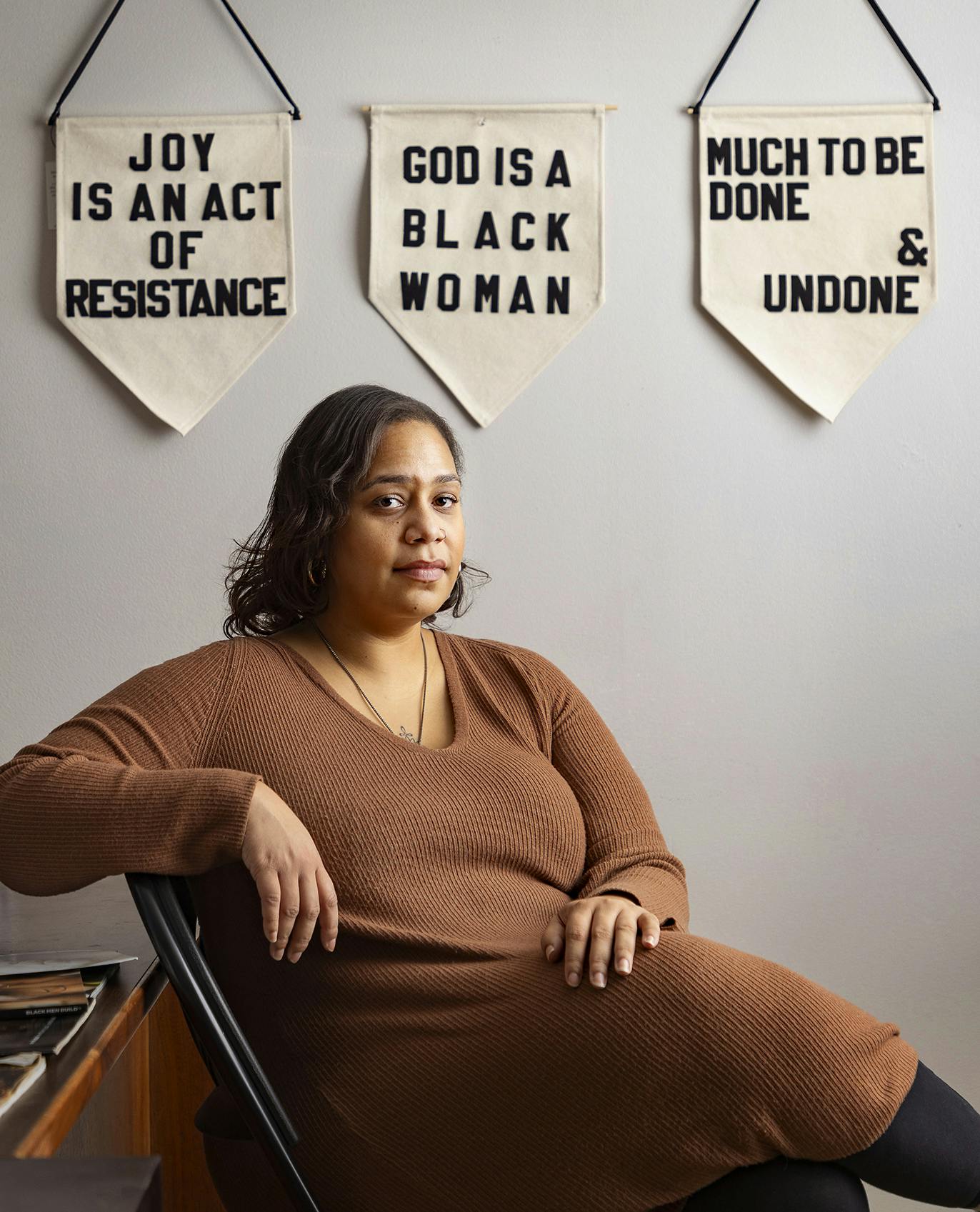
Milwaukee’s outsize role is a big reason why the Democrats chose the city for their national convention in 2020—it largely didn’t happen due to pandemic shutdowns—and then Republicans followed suit for 2024.
“I feel like this [year] is different,” says Angela Lang, founder and executive director of Black Leaders Organizing for Communities, or BLOC, an advocacy group in Milwaukee. “Some voters are aware that how Milwaukee goes can go the rest of the state [when it comes to turnout]. And with Wisconsin being such a swing state, it’s like the epicenter could really just be in Milwaukee.”
At the front of the line, Rosie Redmon waits on the sidewalk outside the red brick walls of Riverside University High School in her wheelchair, pushed by her grandson, Deshawn Hudson. She clutches her purse with hands covered in surgical gloves. A white face mask covers her mouth and nose.
“I sleep in my mask,” the 79-year-old says. “People laugh at me. But I take this seriously.”
Redmon arrived at the school around 5:30 a.m., about an hour before sunrise. It’s one of just five polling sites open across Milwaukee. In a regular election, the city has about 180 polling sites. But this one is happening in April 2020, during the first surge of the Covid-19 pandemic. Other states postponed their elections, but state GOP leaders, backed by a state Supreme Court that was GOP-friendly at the time, overruled Democratic Governor Tony Evers’s efforts to postpone Wisconsin’s. The on-again, off-again messages left city officials extremely short on poll workers, causing them to consolidate into just five sites. Redmon had to get a ride across town from her grandson.
“I’m a voter,” she explains, a tone of defiance in her voice. “I do not miss voting.”
By the time the site opens, late, at about 7:20 a.m., the line behind Redmon stretches about eight blocks, around the side of the school and snaking into adjacent Riverside Park. John Carter stands at the end of it. A coyote briefly appears on a nearby hillside, doing its usual rounds, since there haven’t been people outside for weeks. Carter, a 71-year-old retired bus driver, traveled almost five miles, instead of his usual blocks-long walk to the polls. The length of the line surprised him, especially this early.
“This is what the Republicans in Madison wanted,” he says with a sigh. But he’s not leaving.
“I don’t have anything going on today,” he says. “I got to wait. I got to cast my vote. Except the legs do get tired. I’m an old man.”
All day, the five polling sites in Milwaukee have similar lines. A thunderstorm passes in the afternoon. Voters remain, undeterred. The day became known as the “This Is Ridiculous” election, thanks to a photo of a young woman standing in line holding that handwritten sign. The photo, taken by a Milwaukee Journal Sentinel intern, quickly went viral and generated national news coverage. All that waiting, and national attention, brought surprising benefits. Seeing the oppressive voting situation inspired a surge of poll workers. In the general election in November 2020, Milwaukee opened 173 polling sites, nearly back to pre-pandemic levels. Biden returned the state into Democratic hands, restoring a key piece of the so-called Blue Wall of industrial Midwestern states.
When Trump sued to invalidate the results of the 2020 Wisconsin election, the case was decided narrowly, with four state Supreme Court justices voting against and three for. The “This Is Ridiculous” election produced one key tangible victory, for liberal Supreme Court Justice Jill Karofsky. If that race went the other way, Trump likely would have won his case at the state Supreme Court, launching a constitutional crisis. The voters who waited in those lines may not have realized that democracy and the fate of voting itself was on the line. Ultimately, it was.
“Looking at the heartrending photos and TV footage—voters lined up in the rain, in the midst of an explosive pandemic—to cast ballots in overcrowded precincts in Milwaukee was both a reminder of the lengths that the GOP is willing to go to suppress the vote in Milwaukee and also of the resilience and tenacity of Black voters in Milwaukee who refuse to be disenfranchised,” says Wikler, the state Democratic Party chairman.
President Barack Obama stands at the presidential lectern wearing a button-up blue shirt, gray striped tie, and youthful look. Behind him are red steel structures made at Master Lock, stamped with a black “Made in the U.S.A.” label.
“I’m actually here today because this company has been making the most of a huge opportunity that exists right now to bring jobs and manufacturing back to the United States of America,” he tells the crowd of Master Lock employees in front of him. They applaud loudly. The United Auto Workers members keep cheering other lines.
“Too many factories where people thought they’d retire suddenly left town,” he says. “Too many jobs that provided a decent living got shipped overseas.”
Obama is at this nearly century-old factory on the North Side of Milwaukee a couple of weeks after his State of the Union speech in 2012. He touts his administration’s efforts to save the automobile industry; worker-friendly tax cuts; and financial incentives for companies such as Master Lock that keep production, and workers, in the United States.
The history laid out by Obama has been lived by Don Johnson. He started his first factory job right out of high school at age 19 at AC Delco Electronics, a division of General Motors. He went to work at what turned out to be his last factory job, from ages 59 to 62, as a machine operator at Master Lock. Both jobs paid well, backed by a strong union, and both companies provided steady middle-class incomes to generations of Milwaukee families in the central city. Manufacturers, and all those jobs, were a major reason that Black Americans flocked to the city in the middle part of the twentieth century, most of them fleeing the Jim Crow South. About 9,000 Black people lived in Milwaukee in 1940. By 1970, that number ballooned to about 105,000, according to Census figures. The largest manufacturing employer, A.O. Smith, built automobile frames at its North Side factory.
Both of Johnson’s factory jobs ended the same way: with his departure due to the company downsizing or closing, sending those jobs to be done cheaper abroad. The same fate met most of Milwaukee’s manufacturers. A.O. Smith, for example, finally shut down all operations in 2005 after decades of downsizing.
“The reason that North Side Milwaukee looks like it looks, with abandoned buildings and a lot of vacant commercial space … A.O. Smith started doing what everybody else did. They started making those automobile frames down in Mexico,” he says. “When they shut down [in Milwaukee], those jobs never got replaced.”
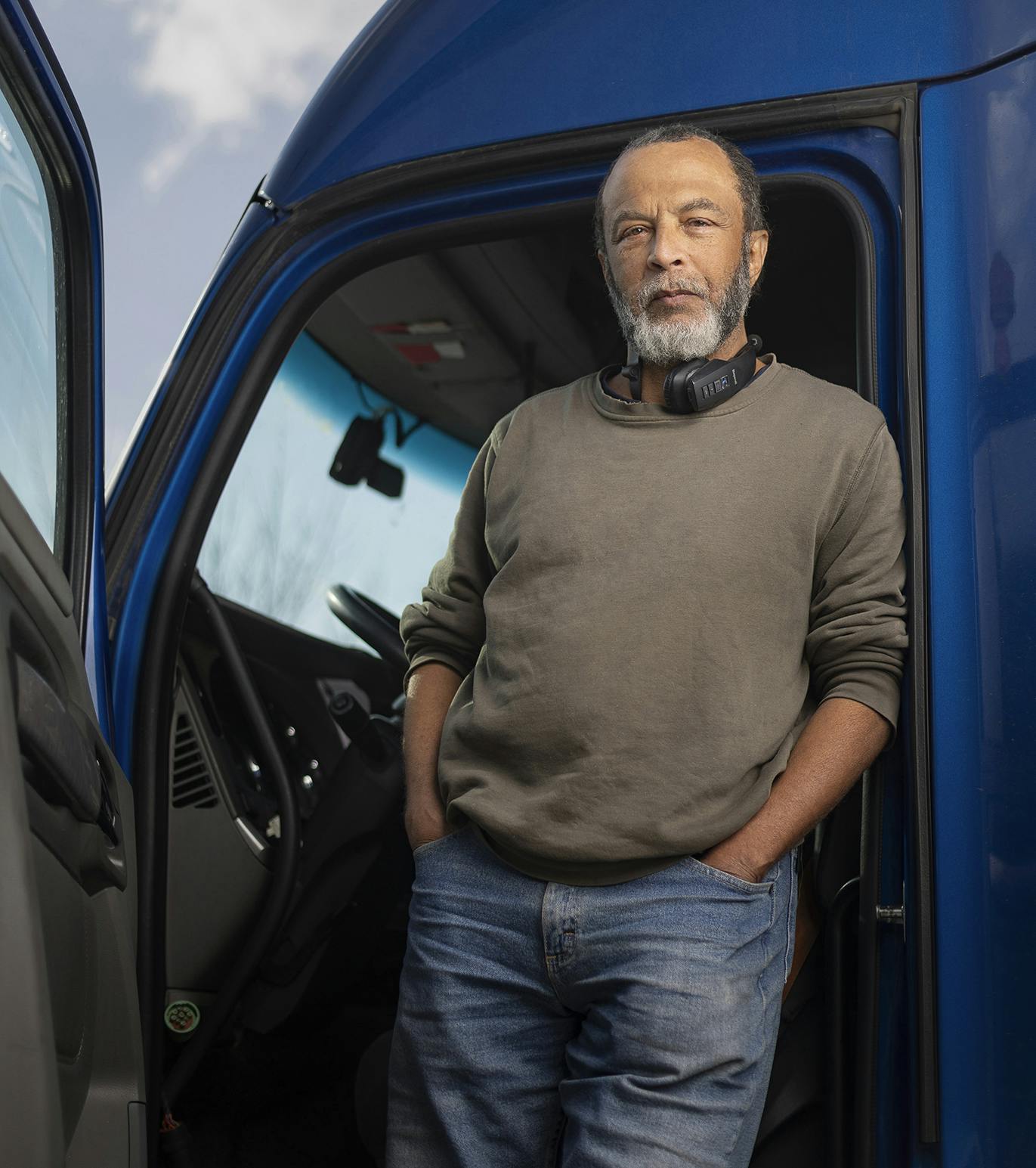
Master Lock’s announcement of its planned closure in March 2024 hit the North Side particularly hard. The company’s sprawling plant has occupied a significant patch of the North Side for more than a century. Johnson said the great majority of his colleagues on the factory floor were also Black. In the decades of industrial decline in Milwaukee, Master Lock remained in the city, offering a steady income—Johnson made $17 an hour on the third shift, with almost unlimited overtime available—and solid benefits.
Today, 11 years after Obama’s visit, the company continues to thrive, earning record revenue of $860 million in 2022. It still operates three shifts around the clock and employs more than 400 people. Johnson took a job there during a forced hiatus from truck driving, which he’s done for decades. While he was very happy at Master Lock, he noticed two things: Parts were increasingly being shipped to Mexico, and machines that were decades old weren’t being updated or replaced. Company officials have offered few details on why they will shut down the factory in 2024, despite pressure from the union and elected officials.
“They were one of the last stable employers right in the inner city, on the bus line,” Johnson says. “So if you got a job there, you had no problem getting to work.”
As Johnson has seen the area’s economy suffer and evolve, he’s also noticed a resulting political shift.
“It is not necessarily guaranteed that Democrats are going to keep getting the minority vote like they’ve been doing traditionally,” he says. “You’re starting to get a lot of African Americans looking Republican.”
People in his generation latched firmly onto the Democrats.
“Because of the civil rights era in the ’50s and the ’60s, the Democrats won over the African American minority community for years,” he says. “So out of tradition, that’s what everybody did…. If they were Democrat, that’s who they voted for. Well, now people are starting to pay attention to the issues and not the party.”
Johnson says Milwaukee is also somewhat the victim of its own success in terms of politics and race. When he was a young adult, he dreamed of a day when Black leaders would run for political office, and win. That used to be a rarity. Today, Milwaukee is a shining example of Black political representation. The city elected Mayor Cavalier Johnson in 2022. The Milwaukee County executive, David Crowley, also is the first Black person elected to the job. The police chief, county sheriff, and superintendent of schools also are Black.
“All of the people in positions of power that we fought for back in the day to make a difference are all there now,” he says. “And it hasn’t changed a damn thing in the Black community. Crime ratio high, unemployment ratio high, you name it.”
It should be noted that most of the Black officials have assumed their current roles only recently, without the requisite time for any policy changes to bear fruit.
Don Johnson is by no means on the Trump train. He views the former president’s alleged theft of classified documents as disqualifying.
“Had it been anyone else, they’d be in prison by now,” he says.
But he’s lived the changes in his community, and knows Democrats have a challenge winning over his children’s generation—he has a son in his thirties who works at an auto parts store and a daughter in her twenties who works at a VA hospital—as they did his.
Mandela Barnes won the Democratic nomination for the U.S. Senate in 2022, and lost in the general election to incumbent Republican Ron Johnson by just under 27,000 votes, around a 1 percentage point margin. The loss left Barnes, 37, at a crossroads, out of elected office and with plenty of options. Ultimately he chose to dig right back into the political game as president of Power to the Polls.
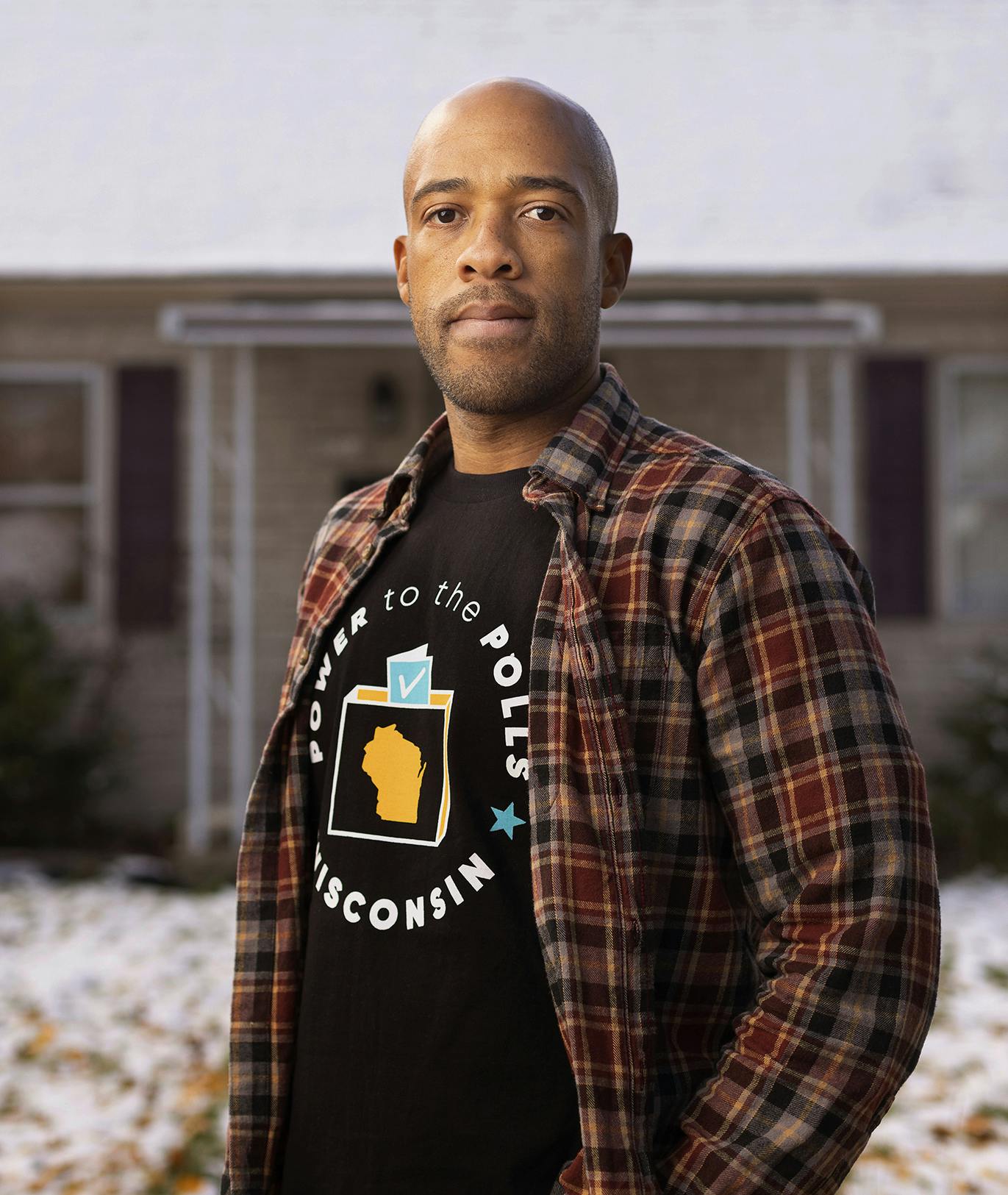
The group was successful in its outreach to Black voters during spring’s state Supreme Court race, the most expensive judicial race in U.S. history, which resulted in the addition of another liberal-aligned justice, Janet Protasiewicz, to the bench. Power to the Polls had 175 ambassadors on the ground as part of a $1 million effort. Barnes says the coming general election will dwarf that, with plans for an $8 million field campaign.
Barnes says the abortion issue resonated in a big way in the group’s organizing for the Supreme Court race. After the Dobbs decision, Wisconsin reverted to an 1849 law that was widely viewed as banning abortion in almost all cases. A state judge’s ruling in summer 2023 cleared the way for abortions to resume in Wisconsin, but a more definitive decision on the issue will ultimately be made by the state’s Supreme Court. Barnes found that the faith community, influential with Black voters, sided with abortion rights.
“[I] often hear pastors in the inner city, more than a lot of people would imagine, talking about the need for this access to exist,” he says.
Power to the Polls joins an existing organizing infrastructure in Milwaukee. Angela Lang’s BLOC has been around for five years. Greg Lewis’s Souls to the Polls, which is affiliated with Barnes’s group, has been in the field since 2013. They’re different groups, but they share the goal of electing Democrats with a playbook heavy on year-round conversations and events hosted by community members.
“We don’t just show up because we want to talk to you about elections,” Lang says, mentioning a back-to-school event sponsored by BLOC. “And so being able to break through some of that transactional parachuting in and then leaving, people are like, ‘Oh, you’re still here; oh, you’re still asking me about my issues. You’re telling me about these things.’ And I think that’s been really valuable.”
The message in 2024 will again be complicated by an imperfect messenger in Biden, who’s dogged by questions about his age and about past verbal stumbles when he’s talked about race. He once said that Black Americans “ain’t Black” if they consider voting for Trump. African Americans also remember Biden’s support, when he was a U.S. senator, of the 1994 crime bill. Wisconsin has the highest rate of Black incarceration in the nation, with one of every 36 Black Americans locked up, according to the Sentencing Project. Lang says Biden wasn’t her first choice, but he has given her plenty to win her support for reelection. She mentions him calling out white supremacy in his inaugural address, his support of the stalled George Floyd criminal justice reform bill, his focus on reducing gun violence, and his support for abortion rights.
“He’s not perfect,” she says of the president. “But, in my opinion, he’s a hell of a lot better than Trump.”
By the 2022 midterms, Riverside University High School is a different place on Election Day. Gone are the eternal lines of the “This Is Ridiculous” election in spring 2020. It’s back to being a regular polling place. A new kind of line has emerged in the gymnasium, painted in the orange-and-black school colors and with its Tiger mascot: They’re first-time voters, almost all of them from one of the nearby colleges.
“We were a lot busier than we expected to be today,” says the polls’ chief inspector, Bill Christianson. “I would say a lot more students and people in their early twenties turned out.”
Adam Elizondo is representative. While he was on break from his night shift at a submarine sandwich restaurant, his mother, Cristina, drove him to Riverside to register—the state allows same-day registration with an approved form of voter ID—and he cast his first-ever ballot before polls closed.
“I’ve been told from a very young age that it’s important to vote,” says Elizondo, a graduate of a Milwaukee public school who’s now in college at University of Wisconsin-Milwaukee. “I feel like it’s important. Everyone should have a say in who controls what we’re doing.”
In the midterms, Wisconsin led the nation in youth turnout percentage. Wikler, the state Democratic Party chair, told The New York Times that registrations for the 35-and-under crowd surged 20 percent from the 2018 midterms to the 2022 midterms. The state party targeted college campuses more aggressively starting in 2019. State Republicans have helped their cause by opposing abortion rights, marijuana legalization, and gun control, among other issues that young voters consistently rank highly.
Milwaukee is a college town, though not known as such to many outside the state; there are eight colleges within city limits and 11 in the region that host about 100,000 students. The city has a potential to play a major role in the youth surge. Lewis’s Souls to the Polls plans to hire an ambassador just for college campuses. The organizer will focus on Milwaukee Area Technical College, whose 28,000 students are more representative of the city’s demographics than other colleges, both racially and economically.
“The young people vote is critical,” Lewis says. “In this upcoming election, you know, we’ve got to make it our business to really go after that vote.”
Winning the youth vote, and matching or exceeding the numbers of the 2022 midterms, could be critical. Or will it be a resurgence among Black voters that proves decisive? Or something else? A year out from a critical election when democracy itself again will be on the ballot, the questions far outnumber the answers in the state with a little bit of everything, and where every election is a game of inches.


